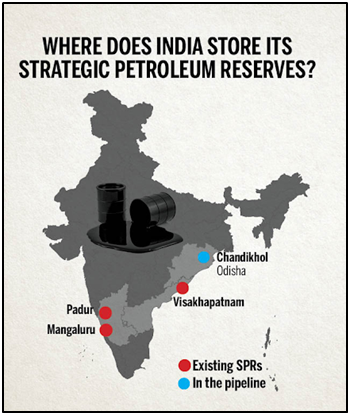Why in News?
- Government-owned engineering consultancy firm Engineers India (EIL) is studying the prospects and feasibility of developing salt cavern-based strategic oil reserves in Rajasthan.
- If the idea comes to fruition, India could get its first salt cavern-based oil storage facility.
- This is in line with the government’s objective of increasing the country’s strategic oil storage capacity.
What’s in Today’s Article?
- About Salt Cavern-based Storage (Meaning, Benefits, Comparison with Rock Caverns, etc.)
- India’s SPR Programme (Objective, SPR Locations, Significance, Phase-2, etc.)
What is Salt Cavern-based Storage?
- Underground storage caverns are used to store very large quantities of unrefined petroleum and natural gas.
- These underground caverns are cavities that have been “mined” out of naturally occurring salt domes.
- Approximately 7% of total underground natural gas storage capacity is in Salt Caverns.
- Salt caverns are developed by the process of solution mining, which involves pumping water into geological formations with large salt deposits to dissolve the salt.
Salt Cavern-based Storage v/s Rock Cavern-based Storage:
- Rock caverns are large man-made spaces in the rock and are considered the safest means of storing hydrocarbons.
- In comparison to rock caverns, salt caverns are considered cheaper and less labour- and cost-intensive.
- Salt cavern-based oil storage facilities are also naturally well-sealed, and engineered for rapid injection and extraction of oil.
- This makes them a more attractive option than storing oil in other geological formations.
- The entire strategic petroleum reserve programme of the United States has so far been based on salt cavern-based storage facilities.
- In comparison, India’s all 3 strategic petroleum reserves are made up of excavated rock caverns.
Potential in India for Storing Crude, Petroleum Products:
- Rajasthan, which has the bulk of requisite salt formations in India, is seen as the most conducive for developing salt cavern-based strategic storage facilities.
- A refinery is coming up in Barmer, and Rajasthan has crude pipelines as well; such infrastructure is conducive for building strategic oil reserves.
- However, no Indian company, including EIL, had the requisite technical know-how to build salt cavern-based strategic hydrocarbon storage.
- This gap in access to technology has been bridged by EIL’s recent partnership with Germany’s DEEP.KBB GmbH — a company that specialises in cavern storage and solution mining technology.
India’s Strategic Petroleum Reserves:

- A strategic reserve is the reserve of a commodity or items that is held back from normal use by governments, in pursuance of a particular strategy or to cope with unexpected events.
- Countries keep strategic reserves of crude oil to meet the immediate demand in times of crisis or unexpected events.
- India, the world’s third-largest consumer of crude, depends on imports for more than 85% of its requirement.
- Government of India through Indian Strategic Petroleum Reserve Ltd. (ISPRL) under Phase–1 has setup Strategic Petroleum Reserves (SPR) at three locations with a capacity of 5.33 MMT (million metric ton) –
- Vishakhapatnam (1.33 MMT),
- Mangaluru (1.50 MMT) and
- Padur (2.5 MMT)
- Taking advantage of low crude oil prices in April-May 2020, the government completely filled these reserves, leading to estimated savings of around Rs 5,000 crore.
- These three SPRs can meet approximately 9.5 days of national demand.
- Apart from SPRs, India’s oil marketing companies (OMCs) have storage facilities for crude oil and petroleum products for 64.5 days — which means there is sufficient storage to meet around 74 days of the country’s petroleum demand.
- Comparison with other Countries –
- The top three countries in terms of such reserves for crude oil are the US, China and Japan.
- Between them, they have 1500 million barrels. At an average daily global consumption of 95 million barrels a day, that’s roughly 20-odd days of oil.
Phase-2 of SPR Programme:
- Under Phase-2 of the programme, government has given in-principle approval for construction of additional SPR facilities at two locations (Chandikhol (4 MMT) and Padur (2.5 MMT)).
- In the second phase of the programme, the government wants to develop strategic reserves through public-private partnershipsso as to reduce government spending and exploit the commercial potential of the reserves.
- India has also decided to commercialize its SPRs. As part of this, Abu Dhabi National Oil Company (ADNOC) stored about 0.8 million tonnes of crude oil in the Mangaluru strategic reserve.









